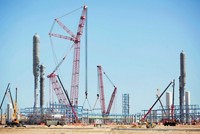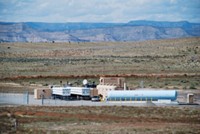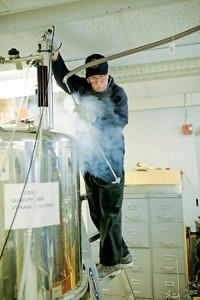Advertisement
Grab your lab coat. Let's get started
Welcome!
Welcome!
Create an account below to get 6 C&EN articles per month, receive newsletters and more - all free.
It seems this is your first time logging in online. Please enter the following information to continue.
As an ACS member you automatically get access to this site. All we need is few more details to create your reading experience.
Not you? Sign in with a different account.
Not you? Sign in with a different account.
ERROR 1
ERROR 1
ERROR 2
ERROR 2
ERROR 2
ERROR 2
ERROR 2
Password and Confirm password must match.
If you have an ACS member number, please enter it here so we can link this account to your membership. (optional)
ERROR 2
ACS values your privacy. By submitting your information, you are gaining access to C&EN and subscribing to our weekly newsletter. We use the information you provide to make your reading experience better, and we will never sell your data to third party members.
Physical Chemistry
As Helium Prices Rise, Universities Consider Recycling The Element
Individual labs and institutions seek to stabilize supplies and price of helium for instruments
by Cheryl Hogue
July 27, 2015
| A version of this story appeared in
Volume 93, Issue 30

Sophia E. Hayes and her research group at Washington University in St. Louis depend on liquid helium to cool the magnets in their nuclear magnetic resonance instruments to a superconducting temperature of 4 K. Her chemistry lab, which in part uses the instruments to study the structure of metal oxide clusters, runs through an average of 157 L of liquid helium every month.
Hayes has watched liquid helium prices balloon from around $7.00 per liter three years ago to more than $17/L these days. Last year, her lab’s bill for the liquefied element hit an eye-popping $35,600.
Hayes is not alone in coping with rising helium costs. Supplies of the element have fluctuated, and helium prices have risen in recent years, taking bigger bites from academic research funds. Both the supply problems and price spikes are connected to the planned shutdown of the Federal Helium Reserve, which for years has been the major supplier of helium gas. That deadline was initially set for 2013, but two years ago Congress pushed it back to 2021. A handful of companies are building facilities to strip helium out of U.S. natural gas deposits and take over the market once dominated by the government, but their efforts are proceeding slowly.
In response to the uncertain atmosphere, academic facilities are considering major investments in equipment to recycle helium for reuse in their instruments. A number have for many years captured much of the helium they use and sold it back to suppliers as low-grade helium gas. Others have simply allowed helium to escape into the air.
Systems to capture, purify, and reliquefy helium on campus require major capital investments. Once installed, the apparatusrequires large amounts of electricity to recompress the helium into a liquid, so running it isn’t cheap. But academics and universities say a recycling system pays for itself in less than five years, given helium’s current price.
Installing a commercial system like this in a single lab is one option for recycling helium but can carry a price tag in the neighborhood of $100,000. Thus many academic research programs are instead opting for centralized helium recycling equipment that serves several instruments, labs, or departments.
For instance, Wilson Ho uses liquid helium to cool the six scanning tunneling microscopes in his lab at the University of California, Irvine. Ho, a professor of astronomy, chemistry, and physics, decided to install a recycling system after liquid helium prices jumped to $11/L. For a single year, his lab shelled out $250,000 to purchase the element.
Instead of buying commercially available recycling equipment, Ho says, “we decided to build it ourselves.” Constructed in about 18 months at a cost of about $500,000, the system has two devices that together produce 60 L/day of liquid helium at a purity of 99.995%, he says. What’s more, because his lab knows the ins and outs of the customized hardware, students maintain and repair the equipment themselves. Now, UC Irvine wants Ho to expand the system to serve its physics, chemistry, and biological sciences departments and is providing his lab with $864,000 to do so.
Likewise, the physics department at the University of Illinois, Urbana-Champaign, recently invested $600,000 in hardware, including compressors and an underground pipeline, to upgrade and expand a recycling system. The physics department now sells recycled liquid helium to campus laboratories for about $15/L.
But installing systems to recycle helium isn’t the clear-cut choice for every academic facility, says Edward I. Solomon, a Stanford University chemistry professor. He says his labs are physically too far from those of Stanford’s physics and applied physics facility to make a centralized helium recycling system practical. Adding individual recycling units to his group’s five instruments that depend on liquid helium would be prohibitively expensive, he says. Washington University’s Hayes says feasibility issues like those Solomon raises are particularly acute for smaller academic institutions.
Hayes worries that the rising price of liquid helium and the cost of on-site recycling equipment is casting a shadow on the future of research fields, including her own, that depend on liquid-helium-cooled instruments.
“Department chairs and executive committees are thinking that this doesn’t look like a good time to invest in NMR,” she says.
Ho, meanwhile, stresses that recycling helium is a sustainability issue with implications larger than just affordability for academic users. Supplies of helium are finite on Earth. If labs simply release the second-lightest element into the atmosphere rather than recycling it, the gas eventually escapes Earth’s gravitational field and winds up in space.
“Once it goes into the air,” Ho says, “it’s gone.”





Join the conversation
Contact the reporter
Submit a Letter to the Editor for publication
Engage with us on Twitter